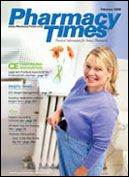ASTHMA WATCH
Heavy Kids with Asthma More Prone to Hospital Stays
Overweight children who present tothe emergency room (ER) with an asthmaattack are more likely to be admitted tothe hospital than children of normal weight.
Researchers at Connecticut Children'sHospital in Hartford reported that this wasthe first study to examine the relationshipbetween pediatric patients with asthmawho are overweight and hospital admissionduring asthma exacerbations. Thefindings were based on a review of all childrenover 2 years of age seen at the hospital'sER for an asthma flare-up in 2005.Only children who had no other chronicmedical conditions were included in thestudy. Overweight in these children wasdefined as being in the 95th or higher percentileof weight-for-age. The results werepublished in the October 2007 issue ofPediatrics.
On average, 813 children made 884 ERvisits for asthma attacks during the studyperiod; of these visits, 27% resulted in ahospital admission, including 4% to theintensive care unit. Of all the ER visitsmade for asthma attacks, 77% involved achild of normal weight, and 23% an overweightchild.
No major differences in asthma severityor in the treatment received in the ERwere noted between the overweight andnormal-weight children; 34% of the overweightpatients with asthma were admitted,however, compared with 25% of thenormal-weight children. The researchersconcluded that "overweight children withasthma have significant health-relatedconsequences as a result of their beingoverweight."
Mom?s Asthma Affects Baby?s Eczema Risk
More information on the effects of maternal asthma onbreast-feeding infants has come from Maastricht University inthe Netherlands, where a study was conducted that found thelonger a mother nurses her infant, the lower the risk of the childdeveloping eczema. This risk increases, however, if the motherhas asthma or allergies. The findings were published in theOctober 2007 issue of the Journal of Pediatrics.
Researchers analyzed data from the 2705 infants enrolled inthe Birth Cohort Study. Questionnaires had been given to themothers after 34 weeks of pregnancy, and at 3, 7, 12, and 24months after birth, asking about breast-feeding, allergy manifestations,and other information. Blood samples were taken duringhome visits between 34 and 36 weeks of treatment.
Of all the infants studied, 2287 were breast-fed. A correlationwas found between a longer duration of breast-feeding and alower risk of eczema in infants of mothers without allergies orasthma; there was no such association for mothers with asthma,however.
Risk of Asthma Death Runs in Families
A study of genealogy records linked with death certificates inUtah suggests that the risk of dying from an asthma attack ishereditary.
Researchers at the University of Utah in Salt Lake City identified1553 asthma-related deaths in a registry of all deaths in thestate since 1904, and found that the risk of dying from asthmaincreased by 69% for first-degree relatives (children, full siblings)of individuals who died from asthma, compared with patientswho died from asthma and had no family history of asthmadeaths. This asthma death risk was higher by 34% for second-degreerelatives (grandchildren, nephews, nieces, and half-siblings)and higher by 15% among third-degree relatives (greatgrandchildren,great-nieces, great-nephews, and first cousins).
The researchers concluded that the results should "providefurther incentive for asthma (health care) providers to thoroughlyquestion patients about family history, as it is a risk factor forasthma mortality." The findings were published in theNovember 2007 issue of American Journal of Respiratory andCritical Care Medicine.
Powder-inhalers Commonly Misused
Researchers from Klinikum Offenburg in Germany reportedthat 1 in 3 patients with asthma are currently using their drypowderinhalers improperly. They also found that the older thepatient, and the more severe the lung disease, the less able thepatient to use the inhaler correctly.
The overall error rate was 32%, but this rate varied with age;in patients younger than 60 years, the error rate was 20%,whereas the rate for patients older than 60 was 41.6%, andamong those older than 80 years, the rate rose to >80%. Thefindings were recently presented at CHEST 2007, the 73rd scientificassembly of the American College of Chest Physicians.
The error rate also varied with disease severity. Amongpatients with normal lung function, the rate was 25%, but inthose with severe airway obstruction, the rate was 63.6%. Errorrates were considerably lower in the patient groups who hadreceived training in the proper use of these inhalers by healthcare providers and higher in those who had not been trained.The researchers found that one third of patients surveyed hadonly been referred to the package insert for use instructions.They expressed concern that "caregivers must adopt modernteaching techniques to meet the educational requirements oftheir patients."
F A S T F A C T : Individuals who live with asthma patients are 3 times more likely to also be diagnosed with the disease.

